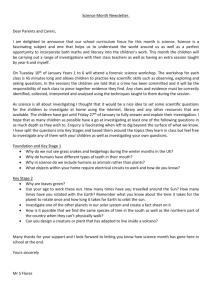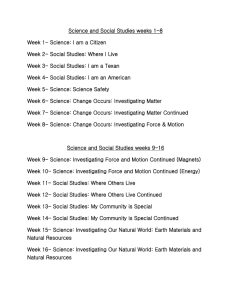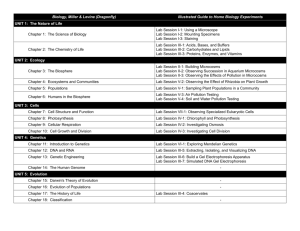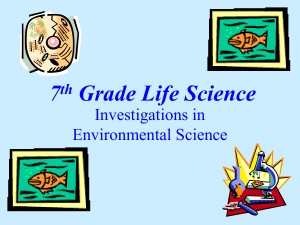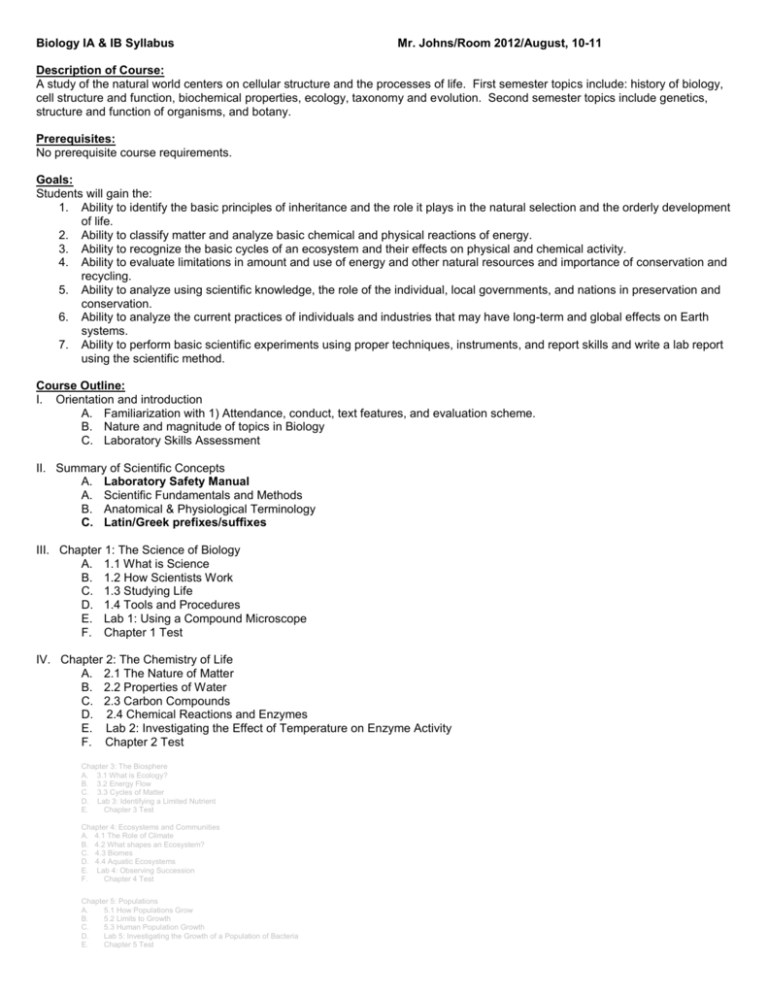
Biology IA & IB Syllabus
Mr. Johns/Room 2012/August, 10-11
Description of Course:
A study of the natural world centers on cellular structure and the processes of life. First semester topics include: history of biology,
cell structure and function, biochemical properties, ecology, taxonomy and evolution. Second semester topics include genetics,
structure and function of organisms, and botany.
Prerequisites:
No prerequisite course requirements.
Goals:
Students will gain the:
1. Ability to identify the basic principles of inheritance and the role it plays in the natural selection and the orderly development
of life.
2. Ability to classify matter and analyze basic chemical and physical reactions of energy.
3. Ability to recognize the basic cycles of an ecosystem and their effects on physical and chemical activity.
4. Ability to evaluate limitations in amount and use of energy and other natural resources and importance of conservation and
recycling.
5. Ability to analyze using scientific knowledge, the role of the individual, local governments, and nations in preservation and
conservation.
6. Ability to analyze the current practices of individuals and industries that may have long-term and global effects on Earth
systems.
7. Ability to perform basic scientific experiments using proper techniques, instruments, and report skills and write a lab report
using the scientific method.
Course Outline:
I. Orientation and introduction
A. Familiarization with 1) Attendance, conduct, text features, and evaluation scheme.
B. Nature and magnitude of topics in Biology
C. Laboratory Skills Assessment
II. Summary of Scientific Concepts
A. Laboratory Safety Manual
A. Scientific Fundamentals and Methods
B. Anatomical & Physiological Terminology
C. Latin/Greek prefixes/suffixes
III. Chapter 1: The Science of Biology
A. 1.1 What is Science
B. 1.2 How Scientists Work
C. 1.3 Studying Life
D. 1.4 Tools and Procedures
E. Lab 1: Using a Compound Microscope
F. Chapter 1 Test
IV. Chapter 2: The Chemistry of Life
A. 2.1 The Nature of Matter
B. 2.2 Properties of Water
C. 2.3 Carbon Compounds
D. 2.4 Chemical Reactions and Enzymes
E. Lab 2: Investigating the Effect of Temperature on Enzyme Activity
F. Chapter 2 Test
Chapter 3: The Biosphere
A. 3.1 What is Ecology?
B. 3.2 Energy Flow
C. 3.3 Cycles of Matter
D. Lab 3: Identifying a Limited Nutrient
E.
Chapter 3 Test
Chapter 4: Ecosystems and Communities
A. 4.1 The Role of Climate
B. 4.2 What shapes an Ecosystem?
C. 4.3 Biomes
D. 4.4 Aquatic Ecosystems
E. Lab 4: Observing Succession
F.
Chapter 4 Test
Chapter 5: Populations
A.
5.1 How Populations Grow
B.
5.2 Limits to Growth
C.
5.3 Human Population Growth
D.
Lab 5: Investigating the Growth of a Population of Bacteria
E.
Chapter 5 Test
Chapter 6: Humans in the Biosphere
A.
6.1 A Changing Landscape
B.
6.2 Renewable and Nonrenewable Resources
C.
6.3 Biodiversity
D.
6.4 Charting a Course for the Future
E.
Lab 6: Observing the Effects of Acid Rain
F.
Chapter 6 Test
V. Chapter 7: Cell Structure and Function
A. 7.1 Life is Cellular
B. 7.2 Eukaryotic Cell Structure
C. 7.3 Cell Boundaries
D. 7.4 The Diversity of Cellular Life
E. Lab 7: Investigating Cell Structures and Processes
F. Chapter 7 Test
VI. Chapter 8: Photosynthesis
A. 8.1 Energy and Life
B. 8.2 Photosynthesis: An Overview
C. 8.3 The Reactions of Photosynthesis
D. Lab 8a: Investigating Photosynthesis
E. Lab 8b: Paper Chromatography
F. Chapter 8 Test
VII. Chapter 9: Cellular Respiration
A. 9.1 Chemical Pathways
B. 9.2 The Krebs Cycle and Electron Transport
C. Lab 9: Investigating Fermentation by Making Kimchi
D. Chapter 9 Test
VIII. Chapter 10: Cell Growth and Division
A. 10.1 Cell Growth
B. 10.2 Cell Division
C. 10.3 Regulating the Cell Cycle
D. Lab 10: Modeling the Phases of the Cell Cycle
E. Chapter 10 Test
IX. Science Fair
A. Required research paper
B. 50 bonus points for being selected to compete in science fair
Chapter 11: Introduction to Genetics
A. 11.1 The Work of Gregor Mendel
B. 11.2 Probability and Punnett Squares
C. 11.3 Exploring Mendelian Genetics
D. 11.4 Meiosis
E. 11.5 Linkage and Gene Maps
F. Lab 11: Modeling Meiosis
G. Chapter 11 Test
Chapter 12: DNA and RNA
A. 12.1 DNA
B. 12.2 Chromosomes and DNA Replication
C. 12.3 RNA and Protein Synthesis
D. 12.4 Mutations
E. 12.5 Gene Regulation
F. Lab 12: Modeling DNA Replication
G. Chapter 12 Test
Chapter 13: Genetic Engineering
A.
13.1 Changing the Living World
B.
13.2 Manipulating DNA
C.
13.3 Cell Transformation
D.
13.4 Applications of Genetic Engineering
E.
Lab 13: Investigating the Effects of Radiation on Seeds
F.
Chapter 13 Test
Chapter 14:The Human Genome
A.
14.1 Human Heredity
B.
14.2 Human Chromosomes
C.
14.3 Human Molecular Genetics
D.
Lab 14: Modeling DNA Probes
E.
Chapter 14 Test
X. Chapter 15: Darwin’s Theory of Evolution
A. 15.1 The Puzzle of Life’s Diversity
B. 15.2 Ideas That Shaped Darwin’s Thinking
C. 15.3 Darwin Presents His Case
D. Lab 15: Modeling Adaptation
E. Chapter 15 Test
XI. Chapter 16: Evolution of Populations
A. 16.1 Genes and Variation
B. 16.2 Evolution as Genetic Change
C. 16.3 The Process of Speciation
D. Lab 16: Investigating Genetic Diversity in Bacteria
E. Chapter 16 Test
XII. Chapter 17: The History of Life
A. 17.1 The Fossil Record
B. 17.2 Earth’s Early History
C. 17.3 Evolution of Multicellular Life
D. 17.4 Patterns of Evolution
E. Lab 17: Modeling Coevolution
F. Chapter 17 Test
XIII. Chapter 18: Classification
A. 18.1 Finding Order in Diversity
B. 18.2 Modern Evolutionary Classification
C. 18.3 Kingdoms and Domains
D. Lab 18: Classifying Organisms Using Dichotomous Keys
XIV. Chapter 19: Bacteria and Viruses
A. 19.1 Bacteria
B. 19.2 Viruses
C. 19.3 Diseases Caused by Bacteria and Viruses
D. Lab 19: Identifying Limits to the Growth of Bacteria
E. Chapter 19 Test
XV. Chapter 20: Protists
A. 20.1 The Kingdom Protista
B. 20.2 Animal-like Protists: Protozoans
C. 20.3 Plant-like Protists: Unicellular Algae
D. 20.4 Plantlike Protists: Red, Brown, and Green Algae
E. 20.5 Funguslike Protists
F. Lab 20: Investigating Contractile Vacuoles
G. Chapter 20 Test
XVI. Chapter 21: Fungi
A. 21.1 The Kingdom Fungi
B. 21.2 Classification of Fungi
C. 21.3 Ecology of Fungi
D. Lab 21: Examining Seeds For Fungi
E. Chapter 21 Test
XVII. Plant Diversity
A. 22.1 Introduction to Plants
B. 22.2 Bryophytes
C. 22.3 Seedless Vascular Plants
D. 22.4 Seed Plants
E. 22.5 Angiosperms – Flowering Plants
F. Lab 22: Comparing Adaptations of Mosses and Ferns
G. Chapter 22 Test
XVIII. Roots, Stems, and Leaves
A. 23.1 Specialized Tissues in Plants
B. 23.2 Roots
C. 23.3 Stems
D. 23.4 Leaves
E. 23.5 Transport in Plants
F. Lab 23: Identifying the Growth Zones in a Plant
G. Chapter 23 Test
XIX. Sponges and Cnidarians
A. 26.1 Introduction to the Animal Kingdom
B. 26.2 Sponges
C. 26.3 Cnidarians
D. Lab 26: Investigating the Responses of Hydras to External Stimuli
E. Chapter 26 Test
XX. Worms and Mollusks
A. 27.1 Flatworms
B. 27.2 Roundworms
C. 27.3 Annelids
D. 27.4 Mollusks
E. Lab 27: Investigating Land Snails
F. Chapter 27 Test
XXI. Arthropods and Echinoderms
A. 28.1 Introduction to the Arthropods
B. 28.2 Groups of Arthropods
C. 28.3 Insects
D. 28.4 Echinoderms
E. Lab 28: Observing Ant Behavior
F. Chapter 28 Test
XXII. Non-vertebrate Chordates, Fishes, and Amphibians
A. 30.1 The Chordates
B. 30.2 Fishes
C. 30.3 Amphibians
D. Lab 30: Investigating Homeostasis in Fishes and Amphibians
E. Chapter 30 Test
XXIII. Reptiles
A. 31.1 Reptiles
B. 31.2 Birds
C. Lab 31: Examining Bird Bones
D. Chapter 31 Test
XXIV. Mammals
A. 32.1 Introduction to the Mammals
B. 32.2 Diversity of Mammals
C. 32.3 Primates and Human Origins
D. Lab 32: Using Fibers as Forensic Evidence
E. Chapter 32 Test
Course requirements:
Students must be familiar with and abide by the school handbook rules for student conduct and the lab procedures and safety rules.
Some reading materials will be provided only during class and students must make the most of their time by taking notes from those
materials. Other materials are available in the library and students are expected to glean information from those materials in an
organized fashion. The student’s Biology notebook, textbook, and other necessary materials are student’s responsibility and must
accompany the student to class each session.
Methods of Evaluation:
Chapter Tests
Lab Participation and Reports
Vocabulary Quizzes
Chapter Worksheets
Class Participation, Notebook, & Science Fair
Semester Exams
Every Grading Period (Possible)
500 points
200 points
300 points
200 points
200 points
100 points *(Weighted 20% of Semester Grade; unless exempt)
Lecture, readings, discussion, audiovisuals, supervised lab investigations.
Required Text:
2008. Biology The Living Science. Kenneth R. Miller & Joseph Levine. Pearson. Prentice Hall.


